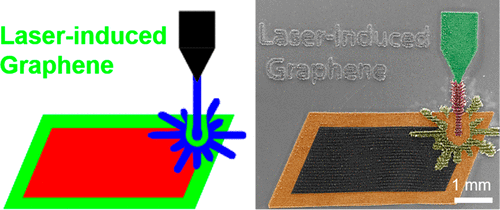当前位置:
X-MOL 学术
›
Acc. Chem. Res.
›
论文详情
Our official English website, www.x-mol.net, welcomes your
feedback! (Note: you will need to create a separate account there.)
Laser-Induced Graphene
Accounts of Chemical Research ( IF 16.4 ) Pub Date : 2018-06-20 00:00:00 , DOI: 10.1021/acs.accounts.8b00084 Ruquan Ye , Dustin K. James , James M. Tour
Accounts of Chemical Research ( IF 16.4 ) Pub Date : 2018-06-20 00:00:00 , DOI: 10.1021/acs.accounts.8b00084 Ruquan Ye , Dustin K. James , James M. Tour

|
Research on graphene abounds, from fundamental science to device applications. In pursuit of complementary morphologies, formation of graphene foams is often preferred over the native two-dimensional (2D) forms due to the higher available area. Graphene foams have been successfully prepared by several routes including chemical vapor deposition (CVD) methods and by wet-chemical approaches. For these methods, one often needs either high temperature furnaces and highly pure gases or large amounts of strong acids and oxidants. In 2014, using a commercial laser scribing system as found in most machine shops, a direct lasing of polyimide (PI) plastic films in the air converted the PI into 3D porous graphene, a material termed laser-induced graphene (LIG). This is a one-step method without the need for high-temperature reaction conditions, solvent, or subsequent treatments, and it affords graphene with many five-and seven-membered rings. With such an atomic arrangement, one might call LIG “kinetic graphene” since there is no annealing in the process that causes the rearrangement to the preferred all-six-membered-ring form. In this Account, we will first introduce the approaches that have been developed for making LIG and to control the morphology as either porous sheets or fibrils, and to control porosity, composition, and surface properties. The surfaces can be varied from being either superhydrophilic with a 0° contact angle with water to being superhydrophobic having >150° contact angle with water. While it was initially thought that the LIG process could only be performed on PI, it was later shown that a host of other polymeric substrates, nonpolymers, metal/plastic composites, and biodegradable and naturally occurring materials and foods could be used as platforms for generating LIG. Methods of preparation include roll-to-roll production for fabrication of in-plane electronics and two different 3D printing (additive manufacturing) routes to specific shapes of LIG monoliths using both laminated object manufacturing and powder bed fabrication methods. Use of the LIG in devices is performed very simply. This is showcased with high performance supercapacitors, fuel cell materials for oxygen reduction reactions, water splitting for both hydrogen and oxygen evolution reactions coming from the same plastic sheet, sensor devices, oil/water purification platforms, and finally applications in both passive and active biofilm inhibitors. So the ease of formation of LIG, its simple scale-up, and its utility for a range of applications highlights the easy transition of this substrate-bound graphene foam into commercial device platforms.
中文翻译:

激光诱导石墨烯
从基础科学到设备应用,对石墨烯的研究比比皆是。为了追求互补的形态,由于自然的可用面积更大,因此与天然的二维(2D)形式相比,石墨烯泡沫的形成通常更可取。石墨烯泡沫已经通过几种途径成功地制备,包括化学气相沉积(CVD)方法和湿化学方法。对于这些方法,经常需要高温炉和高纯气体,或大量的强酸和氧化剂。2014年,使用在大多数机械车间中发现的商用激光划刻系统,空气中直接发射聚酰亚胺(PI)塑料膜可将PI转换为3D多孔石墨烯,这种材料称为激光诱导石墨烯(LIG)。这是一种单步方法,不需要高温反应条件,溶剂,或随后的处理,它可以提供带有许多五元和七元环的石墨烯。通过这种原子排列,人们可以将LIG称为“动力学石墨烯”,因为在该过程中不存在导致重排为优选的全六元环形式的退火。在此帐户中,我们将首先介绍已开发的制造LIG的方法,并控制多孔板或原纤维的形态,并控制孔隙率,组成和表面性质。表面可以从与水具有0°接触角的超亲水性到与水具有> 150°接触角的超疏水性而变化。虽然最初认为LIG工艺只能在PI上进行,但后来证明了许多其他聚合物基材,非聚合物,金属/塑料复合材料,可生物降解的天然材料和食物可以用作产生LIG的平台。制备方法包括用于面内电子设备制造的卷对卷生产以及使用层压物体制造和粉末床制造方法的两种不同的3D打印(增材制造)路线,以形成LIG整块的特定形状。设备中LIG的使用非常简单。高性能超级电容器,用于氧还原反应的燃料电池材料,来自同一塑料片的氢和氧逸出反应的水分解,传感器设备,油/水净化平台以及最终在被动和主动生物膜中的应用展示了这一点。抑制剂。因此,LIG的形成容易,简单的按比例放大,
更新日期:2018-06-20
中文翻译:

激光诱导石墨烯
从基础科学到设备应用,对石墨烯的研究比比皆是。为了追求互补的形态,由于自然的可用面积更大,因此与天然的二维(2D)形式相比,石墨烯泡沫的形成通常更可取。石墨烯泡沫已经通过几种途径成功地制备,包括化学气相沉积(CVD)方法和湿化学方法。对于这些方法,经常需要高温炉和高纯气体,或大量的强酸和氧化剂。2014年,使用在大多数机械车间中发现的商用激光划刻系统,空气中直接发射聚酰亚胺(PI)塑料膜可将PI转换为3D多孔石墨烯,这种材料称为激光诱导石墨烯(LIG)。这是一种单步方法,不需要高温反应条件,溶剂,或随后的处理,它可以提供带有许多五元和七元环的石墨烯。通过这种原子排列,人们可以将LIG称为“动力学石墨烯”,因为在该过程中不存在导致重排为优选的全六元环形式的退火。在此帐户中,我们将首先介绍已开发的制造LIG的方法,并控制多孔板或原纤维的形态,并控制孔隙率,组成和表面性质。表面可以从与水具有0°接触角的超亲水性到与水具有> 150°接触角的超疏水性而变化。虽然最初认为LIG工艺只能在PI上进行,但后来证明了许多其他聚合物基材,非聚合物,金属/塑料复合材料,可生物降解的天然材料和食物可以用作产生LIG的平台。制备方法包括用于面内电子设备制造的卷对卷生产以及使用层压物体制造和粉末床制造方法的两种不同的3D打印(增材制造)路线,以形成LIG整块的特定形状。设备中LIG的使用非常简单。高性能超级电容器,用于氧还原反应的燃料电池材料,来自同一塑料片的氢和氧逸出反应的水分解,传感器设备,油/水净化平台以及最终在被动和主动生物膜中的应用展示了这一点。抑制剂。因此,LIG的形成容易,简单的按比例放大,











































 京公网安备 11010802027423号
京公网安备 11010802027423号